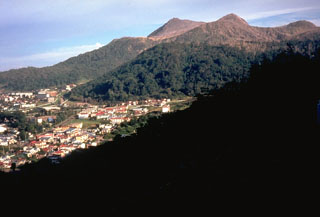Report on Toya (Japan) — September 1978
Scientific Event Alert Network Bulletin, vol. 3, no. 9 (September 1978)
Managing Editor: David Squires.
Toya (Japan) Explosions increasingly frequent; incandescence visible
Please cite this report as:
Global Volcanism Program, 1978. Report on Toya (Japan) (Squires, D., ed.). Scientific Event Alert Network Bulletin, 3:9. Smithsonian Institution. https://doi.org/10.5479/si.GVP.SEAN197809-285030
Toya
Japan
42.544°N, 140.839°E; summit elev. 733 m
All times are local (unless otherwise noted)
Steam explosions were more frequent in August than in July. Explosions, most lasting no more than 15 minutes, occurred on 1, 3, 7-14, 16-20, 24-26, and 28-30 August, causing ashfalls in nearby villages. More than 1 cm of ash was deposited on villages a few km E of Usu after explosions on 16 and 24 August. During the 24 August activity, [an incandescenct column 300 m high] was visible from the base of the volcano for the first time since Usu's major eruption of August 1977. The August explosions produced a 350 x 200 m crater in the S portion of the summit area, engulfing the smaller vent active in July. Crater growth persisted through early September.
The rates of uplift at the new cryptodome . . . continued to decline, to 7 cm/day during August. Local seismicity also continued to decline, to an average of 91 events/day, about 1/6 of which were felt. Tokiko Tiba reported that explosions from 2215-2235 on 12 September and 0030-0217 on 13 September produced a 3-km eruption cloud, accompanied by lightning, and 1-5 cm of ashfall on Toyako-spa, about 3 km NNW of the active crater.
Geological Summary. Usuzan, one of Hokkaido's most well-known volcanoes, is a small stratovolcano located astride the southern topographic rim of the 110,000-year-old Toya caldera. The center of the 10-km-wide, lake-filled caldera contains Nakajima, a group of forested Pleistocene andesitic lava domes. The summit of the basaltic-to-andesitic edifice of Usu is cut by a somma formed about 20-30,000 years ago when collapse of the volcano produced a debris avalanche that reached the sea. Dacitic domes erupted along two NW-SE-trending lines fill and flank the summit caldera. Three of these domes, O-Usu, Ko-Usu and Showashinzan, along with seven crypto-domes, were erupted during historical time. The 1663 eruption of Usu was one of the largest in Hokkaido during historical time. The war-time growth of Showashinzan from 1943-45 was painstakingly documented by the local postmaster, who created the first detailed record of growth of a lava dome.
Information Contacts: JMA, Tokyo; I. Yokoyama, Hokkaido Univ.; T. Tiba, National Science Museum, Tokyo.

